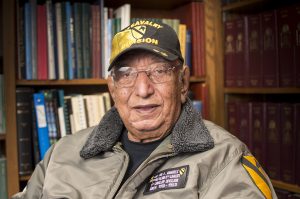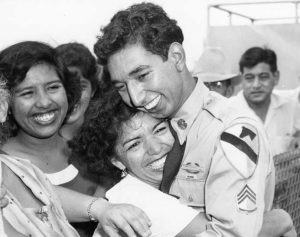Vet who spent time in POW camp with Father Kapaun visits diocese
Vet who spent time in POW camp with Father Kapaun visits diocese
A statue outside of St. John Nepomucene Church in Pilsen depicting Father Emil Kapaun assisting a wounded soldier was inspired by a story about the parish’s favorite son whose heroism during the Korean War lifted the spirits of his men, saved the lives of many, but ultimately led to his death – and to his consideration for canonization by the Vatican.
The statue is a reminder that after Father Kapaun and many of his fellow soldiers were captured, he encountered a struggling wounded soldier and began carrying him while he and other prisoners of war were being marched to a North Korean prisoner of war camp.
The story continues, though. Another soldier, a man baptized by Father Kapaun soon after the soldier’s arrival to South Korea, took over carrying that wounded soldier when Father Kapaun tired.
That Army private, 87-year-old Joe Ramirez – now a retired master sergeant – traveled to the Diocese of Wichita last week to visit Father Kapaun’s hometown and to share stories about the priest who was always a saint to the men in the POW camp.
Ramirez remembers well the events surrounding his capture. It was Nov. 5, 1950. After a difficult firefight on Halloween night, five days before, he and his platoon were anticipating a night attack. They could hear troops advancing on them but couldn’t yet see them in the dark. Eventually, their lieutenant ordered flares to illuminate the battlefield.
“They looked like ants coming at us, thousands of them,” Ramirez said.
The U.S. soldiers were armed only with rifles and three machine guns. The enemy eventually broke through and split the U.S. forces in two. “Half of the guys went to the left and half to the right.”
Ramirez and his fellow soldiers traveled through the mountains for four or five days in an attempt to get back to safety. Instead, they encountered North Korean soldiers and another battle began. Of the 39 in his group, 13 were killed and 12 were wounded before they were surrounded by the enemy.
“So, we put our weapons down and raised our hands,” he said. “They made us take our boots off. They lined us up against a wall, put a machine gun in front of us and the man cocked it. He was getting ready to tell us ‘good-bye.’”
Ramirez said while standing in front of the machine gun he reached into his pocket and pulled out two pieces of candy. He gave one to a buddy next to him and said: “One for the road.”
“What do you mean by that,” his fellow soldier said.
“Well, you see that man up there with a machine gun,” Ramirez answered. “He’s fixing to kill us.”
Moments later a Chinese officer, many of whom spoke excellent English because of their education in the U.S., walked over to the machine gun and kicked the gun and the Korean soldier over.
“He told us to put our boots back on,” Ramirez said.
During their march to a POW camp, the prisoners were often hidden in sheds, away from U.S. jets looking for targets.
On the second day, Ramirez’ group caught up with Father Kapaun, who was carrying a wounded soldier. Ramirez’ commanding officer, Captain William “Moose” McClain, told him to relieve Father Kapaun.
“So I took that soldier off his back and I carried him the rest of the way,” he said.
One night while they were being kept at a temporary camp in a frigid valley, Ramirez left his shed in order to relieve himself and saw Father Kapaun. “I said, ‘What are you doing out here in this weather?’ He said, ‘I’m checking on my boys, trying to lift up their spirits and make sure they don’t give up.’ So I left him and he kept going through every shed.”
Their march ended weeks later at Camp 5, Camp Pyoktong, near the Yalu River, which is the border of northwest North Korea and China. It was a region where the temperature that winter dropped to 50 degrees below zero.
The camp’s conditions were horrible, Ramirez said, adding that they spent much of their time killing lice by the thousands, and attempting to survive on a diet of millet, barley, cracked corn, and turnips. Eventually, they built their own latrines and the Chinese camp personnel brought in DDT to kill the lice.
When the weather warmed up six months later, he said, the POWs were allowed to walk to the river for their first bath in six months. Ramirez said he was stunned at the sight of “walking skeletons.”
He weighed 85 pounds when the camp was liberated.
About 1,600 POWs died of disease or starvation from December of 1950 through May of 1951, he said, and were buried by their fellow soldiers by being entombed by rocks because they were unable to dig graves for them in the rocky and frozen ground.
“Father Kapaun was very gentle and kind, easy going, always with a smile in his face. Always gave the last rites. He was a supervisor of all these guys that died. The reason for that, what Father Kapaun did, he would take their clothes off and wash them and gave him to the next person that needed them.”
Ramirez said he remembers May 23, 1951, the day Father Kapaun died, months after the priest’s health began deteriorating.
“Father Kapaun was the best thief that you could find,” he said. “He stole food and clothing and gave it to the guys who were sick or who needed them really bad.”
“The Chinese were afraid of Father Kapaun,” he said, which was the reason he was eventually moved to the “death” hospital. On the day Father Kapaun died, the entire camp became quiet, he added. “They knew who he was and what he did and they loved him. And I’m talking about everybody.”
Ramirez says he still thinks of Father Kapaun. “I loved the man, not only me, everybody loved him. He was a very gentle, kind, with a big smile on his face at all times even though he was sick. He was always alive and always smiling and talking.”
Ramirez visited the diocese Monday through Friday, March 25-29. In addition to visiting the Father Kapaun Memorial and Museum and St. John Nepomucene Church in Pilsen, spoke to students at St. Elizabeth Ann Seton School, parishioners of St. Francis of Assisi Parish in Wichita, delivered a talk to the student body at Kapaun-Mt. Carmel High School, and to classes at Bishop Carroll in Wichita and St. Mary’s Colgan in Pittsburg. The veteran ended his tour of the diocese by speaking to the Kapaun’s Men group in Pittsburg.
Scott Carter, the coordinator of the Father Kapaun Guild, said it was a joy and an honor to welcome Ramirez to Wichita.
“Joe really wanted to visit the Father Kapaun memorial and museum in Pilsen as a way to honor the chaplain who showed him so much love and encouragement during his time on the battlefields and in the prison camp of North Korea,” he said
“You could see the pride on his face when he held Father Kapaun’s Medal of Honor. When we asked him what he did to keep Father Kapaun’s memory alive, Joe shared that Father Kapaun has been in his heart ever since he died in 1951.”
Carter said Ramirez enjoyed meeting the hundreds of people who came to hear him talk.
“I think he was struck by the hospitality, respect and love that he was shown by so many people whom he had never met, but who were inspired by his own personal story and grateful for sharing memories of his friendship with Father Kapaun.”


